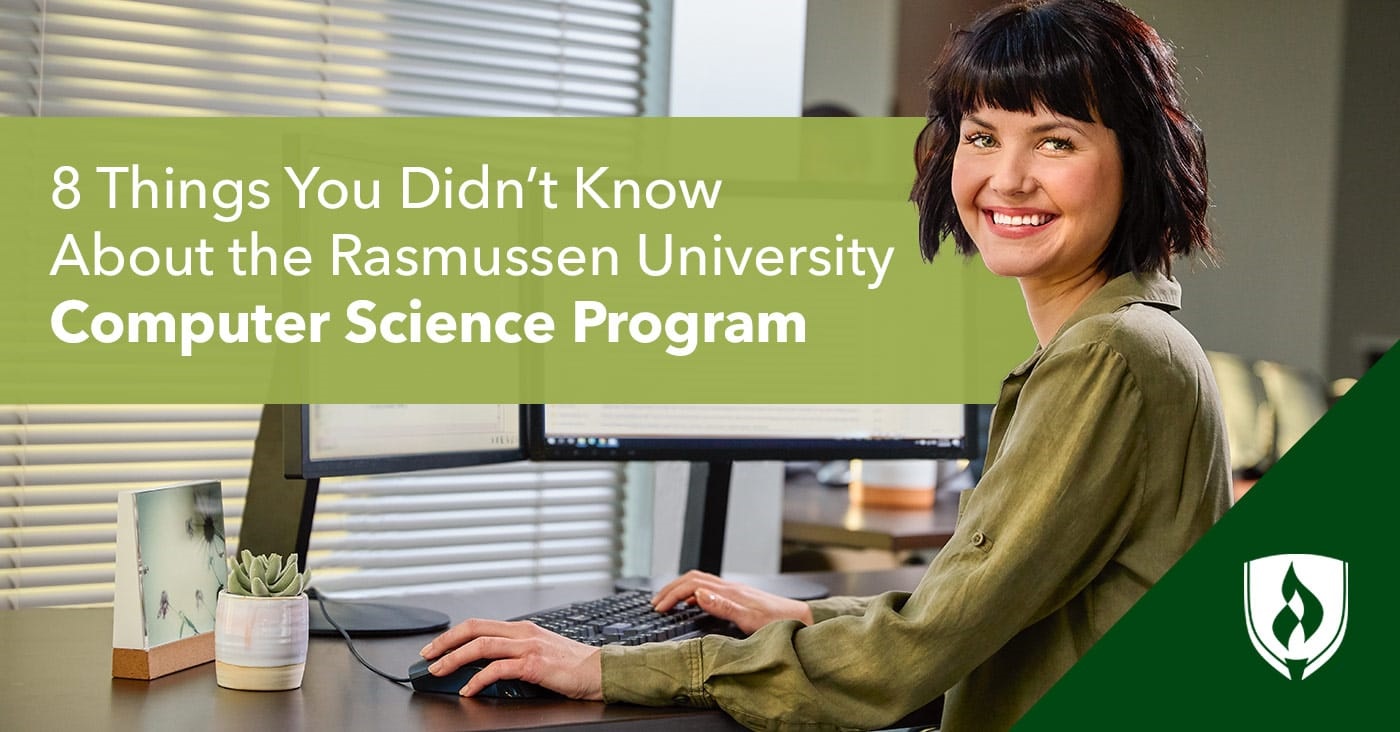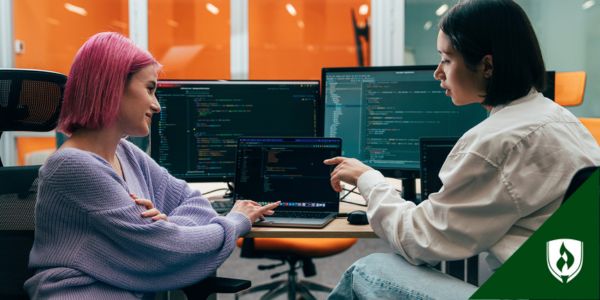8 Things You Didn't Know About the Rasmussen University Computer Science Program
By Callie Malvik on 10/24/2019
You’re ready to make a change. Maybe you’ve spent some time working your way through the ranks of an IT department and would like to shift gears. Or maybe you’ve been working in a completely unrelated field while secretly exploring an interest in programming and software development. No matter the path you’ve taken to reach this point, you know earning a Computer Science degree is the next logical step as you pursue a new career trajectory.

Of course, finding the right Computer Science program for you isn’t always easy. There are a lot of options out there and you want to make sure your chosen program equips you with the skills employers are seeking while still remaining flexible enough to fit your life.
So how does the Rasmussen University Computer Science program stack up? Let’s take a closer look at some of the key facts you may not know about the program.
8 Standout features of the Rasmussen University Computer Science program
If you’re considering enrolling in the Rasmussen University Computer Science program, there are a few features you should be aware of. Consider the following information:
1. The curriculum was designed with direct input from industry experts
The relatively rapid pace of change in technology careers is no secret—the trends that are top-of-mind this year may taper off next year. That’s part of what can make developing a Computer Science curriculum challenging. One way to avoid chasing the next flash in the pan is to rely on the expertise of professionals who’ve seen the field mature throughout their careers.
The Rasmussen University Computer Science program does just that with curriculum-design experts who have extensive technical experience working for organizations like Intel, Hewlett Packard Enterprise, Lockheed Martin, the Kennedy Space Center and the Bureau of Indian Affairs. Curriculum-design subject matter expert Sam Berry says his professional experience led him to focus on ensuring students will be fundamentally sound upon completion of the coursework.
“I tried to emphasize an understanding of the basics,” Berry says. “I have seen too many people try to implement advanced concepts without understanding the underlying basic items. Invariably, this will cause the advanced concepts to fail.”
Students in the Rasmussen University Computer Science program can be confident they are being trained in the most important, fundamental skills needed to establish a long-lasting career in the industry. Equipped with this foundation of knowledge, graduates will be in a better position to learn and adapt to the new trends that will inevitably sprout up throughout their careers.
2. Courses incorporate hands-on projects
You’re a practical person and know that all the abstract and theoretical computer science knowledge in the world isn’t going to do you much good professionally if you don’t understand how to apply it. That’s a big part of why the curriculum at Rasmussen University focuses on incorporating hands-on projects that closely mimic the type of work you’ll do in a professional software development career.
Not only will these assignments help you build a stronger practical understanding of what you’re learning, they can also help build your professional portfolio of projects. Additionally, you’ll have more tangible experiences to draw from when it’s time to ace your next job interview.
“The capstone course projects are designed in a manner to reflect a real-world project,” Berry says. This comprehensive project pushes students to showcase their grasp of key industry competencies like software design, development, algorithms, data management, and information quality and security.
3. All instructors have practical field experience
While what is covered in a Computer Science curriculum is certainly an important factor to consider, it’s also worth considering who is teaching that curriculum. Across the board, instructors in the Rasmussen University Computer Science program have extensive industry experience. This experience is a valuable asset. It gives you the opportunity to learn from what they’ve seen in their professional careers and help you get a better feel for what at times abstract concepts look like and how they’re applied outside of a classroom setting.
“We truly believe that the most passionate and relevant instruction comes from folks who have a great deal of experience in the industries of which they’re preparing graduates to enter,” says School of Technology dean Jennifer Ayotte. “Faculty members are able to share real workplace scenarios, project problems and client stories that help students get a taste for what working in the field will be like.” She adds that it also makes for interesting anecdotes that help bring to life the very content they’re learning in class.
4. Online and competency-based education (CBE) courses allow additional flexibility
While “online competency-based education” certainly is a string of words that might not mean much to you right now, bear with us—there’s a lot to like when you get into the details. Online competency-based education is a method of instruction and evaluation that focuses less on the amount of time you spend sitting in a classroom and more on what you actually know.
You’re probably wondering how that’s any different from other classes you’ve taken. After all, most courses have tests, quizzes or other assessments along the way. What sets CBE apart is the pacing and potential for flexibility. With CBE courses, if there’s a particular subject you’re already familiar with, you have the ability to work ahead and complete assignments ahead of schedule. On the flip side, if there’s an area you feel needs a bit more attention, you have the ability to slow down and devote extra time to ensure you’ve comprehended the material.
This format gives you an opportunity to earn credit for existing knowledge and additional flexibility for when you complete assignments—an appealing option for anyone balancing work and school. The Rasmussen University Computer Science program can be completed entirely online, and more than half of the course work is in this CBE format.
5. The program is designed for graduates to meet employer demand
Software development professions are on the rise. The Bureau of Labor Statistics projects jobs for software developers to grow 21 percent by 2028.1 These roles can be tricky to fill as employers are seeking candidates with a broad base of skills like Java, software development principles, SQL, databases, JavaScript, operating systems and quality assurance.2
Ayotte says meeting the needs of employers nationwide was a key consideration when developing the Computer Science program curriculum.
“Computer Science is a nationwide, and worldwide, need within practically every kind of business out there,” Ayotte says. “We have students from every state, and even from U.S. territories, coming to us for relevant programs that meet the top employer demands—so we have to ensure our curriculum and courses are built around those top demands regardless of state or zip code.”
Throughout the program, students will complete courses covering subjects like:
- Programming languages and scripting
- Operating systems
- Software engineering
- Database systems
- Algorithms
- Software security
- Quality assurance
- Big data
- E-commerce development
These subjects will help students develop a strong foundation of the critical computer science skills employers are seeking. This will provide you a launch point for specialized computer science roles like software developer, software engineer and quality assurance analyst.
6. Graduates will be prepared for industry certifications
Graduates of the Rasmussen University Computer Science program will be prepared to hit the ground running when it comes to seeking industry certifications. The program curriculum prepares students to earn both the Java Foundations Certified Junior Associate and Database Foundations Certified Junior Associate certifications from Oracle®.
“Java development is a much needed skill in business,” says industry expert and curriculum consultant Ken Barr. “We put a lot of thought into what skills hiring managers are looking for from entry-level personnel.”
Even better? Students in this program who seek these certifications will be reimbursed exam fees for their first attempt of up to three certification exams for which they qualify.3
7. The program can be completed in as few as 18 months4
While the Rasmussen University Computer Science program does offer several features that allow for additional flexibility in how you tackle your coursework, it’s not unreasonable to want to finish your schooling as soon as possible. There’s no denying balancing work and school can be a challenge, but for those with an Associate’s degree, this Bachelor-completer program can be completed in as few as 18 months.4
Additionally, the format of this Computer Science program means you’ll have the ability to attend classes year-round, which can help keep your time in school densely-packed. This helps minimize the length of time between where you are now and your job search for the computer science career you’ve set your sights on.
8. Rasmussen University is accredited by the Higher Learning Commission
Accreditation may not be on the top of your mind, but it’s certainly worth considering. It’s no secret that there are plenty of places—both accredited and unaccredited—where you can pick up on software development and programming skills online. But completing a program from an accredited school demonstrates you’ve received your training from an institution that has been independently reviewed and meets certain education quality standards.
Couple that fact with the technical knowledge, hands-on project experience and job search skills you’ve refined with the help of Rasmussen University’s Career Services advisors and you’ll be ready to get to work in your new career.
Ready to start a Computer Science program?
Now that you know more about the Rasmussen University Computer Science program, are you ready to get started? If so, visit the Rasmussen University Computer Science program page to learn more!
Related Articles:
1Bureau of Labor Statistics, U.S. Department of Labor, Occupational Outlook Handbook, [accessed September, 2019] www.bls.gov/ooh/. Information represents national, averaged data for the occupations listed and includes workers at all levels of education and experience. Employment conditions in your area may vary.
2Burning-Glass.com (analysis of 979,216 software development and computer programming job postings, Sept. 1, 2018 – Aug. 31, 2019).
3Rasmussen University will reimburse students’ application fee for each first attempt of up to three industry certification exams for which you qualify. Should you need to take an exam more than once to receive a passing score, you will be responsible for all subsequent exam application fees. Rasmussen University will provide practice exams and materials when available.
4Completion time is dependent on transfer credits accepted and the number of courses completed each term.
Java, JavaScript and Oracle are registered trademarks of Oracle Corporation.
Rasmussen University is accredited by the Higher Learning Commission (hlcommission.org), a regional accreditation agency recognized by the U.S. Department of Education.




